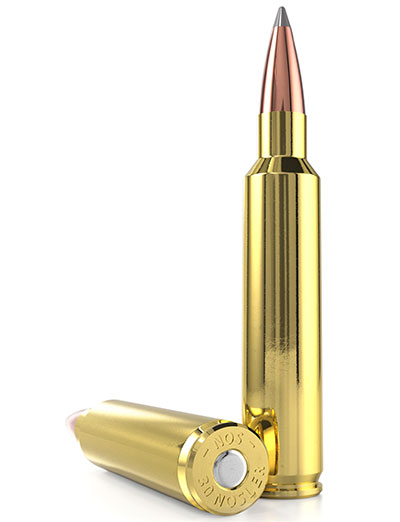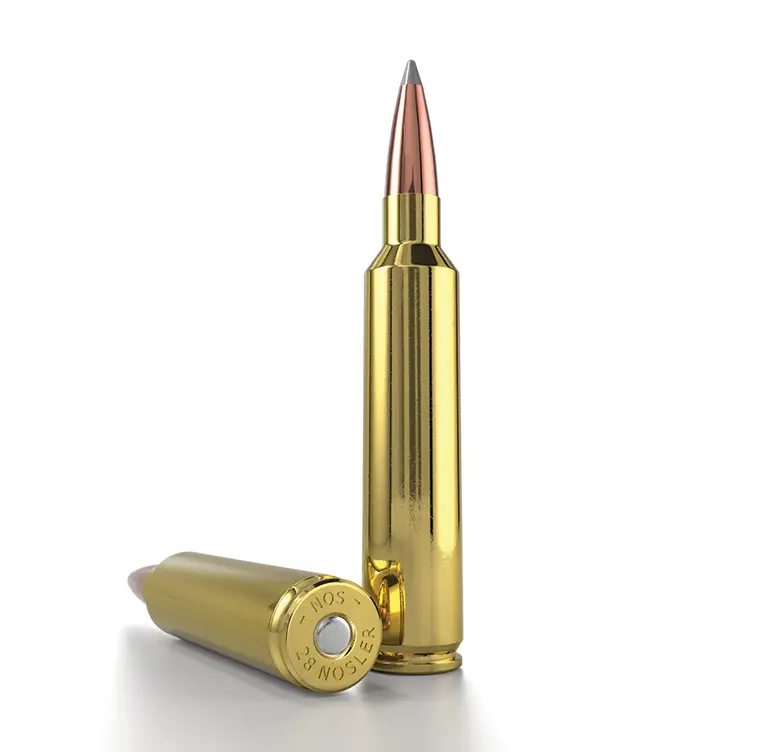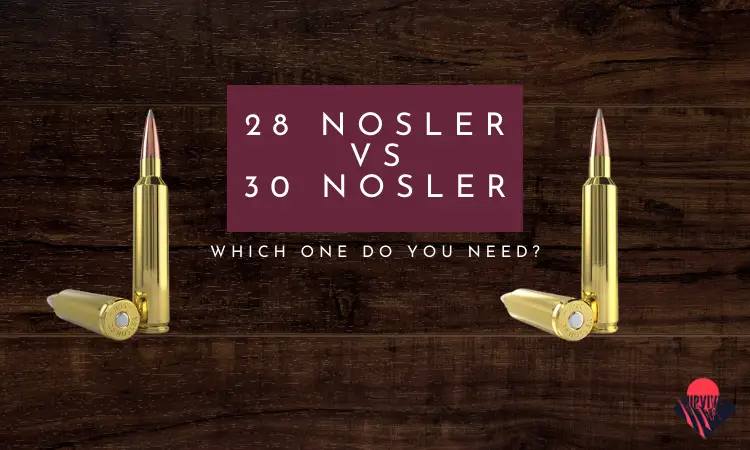In the world of rifle cartridges, Nosler is a familiar name. They have an amazing line of cartridges. Some of which have become household names in the world of hunting. So, when it comes to choosing one between them, it becomes an uphill climb.
So, 28 Nosler Vs 30 Nosler, which one should you go for?
The 30 Nosler takes the edge on certain features due to its size. These include the velocity, range, and drop rate of both of them. It also has a larger barrel life. However, 28 Nosler takes the edge on barrel life.
Keep in mind, there are a lot more factors at play than the basics. In this article, we’re going to settle the debate once and for all. So, let’s begin!
Table of Contents
28 Nosler vs 30 Nosler: Quick Difference
Before we get into the details, let’s give you a quick rundown of the features. This will help you when we get into the technical details later.
To get a quick overview of the cartridges, check the following table-
| Feature | 28 Nosler | 30 Nosler |
| Muzzle Velocity | 3125 fps | 3200 fps |
| Muzzle Energy | 3470 ft-lbs | 3639 ft-lbs |
| Supersonic Range | 1750 yards | 1150 yards |
| Drop Rate | Less | More |
| Terminal Energy | More | Less |
| Windage | Less | More |
| Recoil | 30 ft-lbs | 31.58 ft-lbs |
| Barrel Life | 700-900 rounds | 2000-4000 rounds |
In this table, you can see all the relevant information about 28 Nosler and 30 Nosler. If these seem confusing, don’t worry! Keep reading as we go in-depth to help you out!
28 Nosler vs 30 Nosler: Head to Head
Now that the pleasantries are out of the way, let’s get into the technical aspects of the cartridges. There are a lot of underlying factors that determine the efficiency of a cartridge. So, knowing in-depth about such factors is a good idea.
We’ve divided our discussion into several aspects to help you out. These include-
Ballistics
The science behind the velocity, trajectory, and impact of a bullet is called ballistics. While a simple bullet might look normal, the science behind it is very fascinating. Understanding ballistics is the key metric to judge a bullet’s capability.
When it comes to comparing ballistics, we have to set some grounds first. Now, some typical features of a bullet are velocity, energy, time of flight, etc. They can be seriously affected by the weather. Since we don’t have any control over that, our calculations were done in the most neutral way possible.
The ballistics will be discussed following the standards set by the International Standard Atmosphere (ISA). So that we can keep the comparisons as neutral as possible. The standard metrics include –
- Temperature: 59 F
- Altitude: 0 ft
- Inclination: 0 degrees
- Wind Speed: 10 mph
- Wind Direction: 90 degree
The grain of the bullets also plays a key role in determining the ballistics of the bullet. So, we chose the best versions of the bullets to help you out. We’re using the 175 grain 28 Nosler and 180 grain 30 Nosler to determine the ballistics.
However, keep in mind that the condition of the gun also plays a key role in determining ballistics. The zero range of the rifle as well as the height of the sight should be taken into account. Here the height of the sights is 1.5” from the rifle, which is considered ideal.
But, if you’re calculating ballistics, make sure your rifle sight is of good quality. Rifle sights like the Pinty Red Green Reflex Scope or the Bushnell Trophy TRS-25 are worth a shot! From clear vision and multiple filters, they give you a very sight regardless of the situation!
Here are the 28 Nosler and 30 Nosler ballistics charts over a trajectory of 2000 yards-
28 Nosler Ballistic Chart
| Range (yards) | Velocity (fps) | Energy (ft-lbs) | Elevation (inches) | Windage (inches) | Time of flight (sec) |
| 0 | 3125 | 3470 | 0 | 0 | 0 |
| 100 | 2962 | 3117 | 0 | 0.51 | 0.1 |
| 500 | 2367 | 1991 | -38.5 | 12.9 | 0.55 |
| 1000 | 1731 | 1065 | -236.1 | 59.3 | 1.29 |
| 1500 | 1248 | 553 | -734.7 | 156 | 2.31 |
| 2000 | 992 | 350 | -1796.8 | 312.9 | 3.68 |
30 Nosler Balistic Chart
| Range (yards) | Velocity (fps) | Energy (ft-lbs) | Elevation (inches) | Windage (inches) | Time of flight (sec) |
| 0 | 3200 | 3639 | 0 | 0 | 0 |
| 100 | 3034 | 3271 | 0 | 0.49 | 0.1 |
| 500 | 2429 | 2097 | -36.38 | 12.53 | 0.54 |
| 1000 | 1783 | 1130 | -223.51 | 57.25 | 1.26 |
| 1500 | 1282 | 584 | -694.64 | 150.71 | 2.25 |
| 2000 | 1007 | 360 | -1701.25 | 304.64 | 3.59 |
In this table, we’ve presented the basic 28 Nosler and 30 Nosler ballistics chart. From the table, you can see the change in velocity, elevation, energy, windage based on distance and time of flight.
From the chart, you can see the gradual change of these metrics. To help you understand the ballistics, we’re going to discuss them in detail!
Ballistics 1: Velocity
When it comes to velocity, both muzzle velocity, and change velocity after shooting is important. It’s the velocity of the bullet at the time of leaving the rifle. However, the key metric to judge a bullet’s capability is its velocity once it’s out of the rifle.
Generally, higher velocity is attributed to higher impact during contact. So, if the bullet maintains a higher velocity in its trajectory, it’s going to go a long distance as well as have a better impact while hitting the target.
To help you understand better, here’s a chart showing the change of velocity for Nosler 28 and 30 over a distance of 2000 yards-
In the chart, you can follow the potential loss of velocity over time for both of these bullets. Through the entire trajectory, 30 Nosler consistently maintains higher velocity. From that, we can determine the Ballistic Coefficient for both of them.
Ballistic Coefficient refers to the bullets’ ability to deal with air resistance. The 30 Nosler has a Ballistic Coefficient of .507 while the coefficient for the 28 Nosler is .615.
However, another factor in consideration is the weight of the bullets. The 28 Nosler bullets are 175 grains, while the 30 Nosler bullets are 180 grains. Since the 28 Nosler bullets are lighter, they can stay in the air longer.

The 30 Nosler has an almost similar Ballistic Coefficient. Pair that with its heavier weight and it takes the edge. It has a higher momentum on air, so strikes from the 30 Nosler are far more impactful.
Ballistics 2: Trajectory
Trajectory refers to the path of the bullet once it has left the gun. It takes into account relevant factors such as gravity, the weight of the bullet, atmospheric conditions, etc. For a bullet to be accurate, its trajectory has to be as smooth as possible.
Now, we’ve seen how the 30 Nosler survives the air better than 28 Nosler. As a result, it gets the advantage of trajectory as well. To understand it better, check the curve-
In the chart, you can see that both the bullets start in very similar trajectories. However, as bullets start going the distance, the 28 Nosler starts dipping in elevation. The trend continues for as long as the bullets propagate further.
Here the trajectories are very similar and the dip is very little. But it’s safe to say that the 30 Nosler is definitely going to be more on-target than the 28 Nosler.
Ballistics 3: Energy
Understanding energy can be a bit troublesome at times. Here, energy refers to the damage caused by the bullet. The higher the energy while impact, the more damage the bullet will cause. Muzzle energy plays a key role in this regard.
Muzzle energy means the energy of the bullet at the time of leaving the gun. If the muzzle energy is higher, it will leave the bullet with higher energy. The 28 Nosler has a muzzle energy of 3470 ft-lbs, and the 30 Nosler has muzzle energy at 3639 ft-lbs.
To help you understand the flow of energy, check out the chart–
The key here is to see the change of energy over time and monitor the rate of change. The velocity also comes at play here since kinetic energy is determined based on velocity and the formula is-
Kinetic energy = 1/2mv^2
Now, 30 Nosler has higher elevation energy at the start due to its higher muzzle velocity. And, it maintains the trajectory throughout the entire path of the bullets. So, during impact, it will have a bigger collision.
Ballistics 4: Windage
Wind velocity plays a key role in the trajectory of any bullet. Now, Bullets are generally small and lightweight. So, the air can control the path of the bullet, eventually taking it away from its target.
Now, If you shoot in a straight line to reach your target, it will very likely be moved out of position. The change in position is determined by the velocity of the wind and other factors. So, you have to shoot a bit away from the target, keeping in mind wind direction and windage.
To know more, check the chart for the windage of 28 and 30 Nosler. Here the wind velocity was 10 mp/h at a 90-degree angle.
The chart will help you get an idea about the windage and change of windage of the bullets based on distance.
However, the windage depends on a lot of external factors. So, it can be different at different times of the season.
Cartridge Size Specification
The size of the cartridge is another key factor. To help you understand, here are the cartridge size details for 28 and 30 Nosler
| Specification | 28 Nosler | 30 Nosler |
| Parent Case | .300 Remington Ultra Magnum | .300 Remington Ultra Magnum |
| Bullet Diameter | 7.21 mm | 7.82mm |
| Neck Diameter | 8.1 mm | 8.7mm |
| Shoulder Diameter | 13.4 mm | 13.4mm |
| Base Diameter | 14.0 mm | 14.0mm |
| Rim Diameter | 13.6 mm | 13.6mm |
| Rim Thickness | 1.3 mm | 1.3mm |
| Case Length | 65.8 mm | 64.9mm |
| Overall Length | 84.8 mm | 84.8mm |
| Primer Type | Large Rifle Magnum | Large Rifle Magnum |
The information here is pretty self-explanatory. The table has all the information you need about the cartridges to help you make your choice! Also, when it comes to ammo, knowing how to store your ammo is as crucial as getting the right one!
Recoil
For a lot of shooters, recoil is the most intimidating part of their shooting experience. But, recoil is a necessary evil for any weapon. It’s the backward energy you face whenever you shoot a weapon.
If the recoil is high, the backward energy is also higher. If you’re using a weapon with higher recoil, you need to prepare yourself for that. These include getting the right protective equipment, such as shooting gloves, recoil pad, glasses, etc. Furthermore, having the right stance and posture is a great way to deal with recoil.
If you’re wondering which shooting gloves to go for, check out our suggestions-
Now, the 28 Nosler has a recoil of 28.27 ft-lbs. On the other hand, the 30 Nosler’s recoil rate is 31.58 ft-lbs. Due to its heavier size and higher muzzle velocity, its recoil is also higher. So, keep that in mind and prepare accordingly!
Effective Range
In layman’s terms, effective range means how far the bullet can go with maximum accuracy. Once the bullet crosses its effective range, it starts losing accuracy. One of the easiest ways to measure a bullet’s effective range is by its supersonic range.
The 28 Nosler has a supersonic range of almost 1700 yards for a flight time of 2.85 seconds. Meanwhile, the supersonic range of 30 Nosler is 1750 yards for 2.82 seconds. So, how do you know when they’re the most effective?
The best way to determine such efficiency is by checking their trajectory. According to the chart above, both of these bullets start losing velocity within the first 300-500 yards. So, they’re the most effective in that range.
Another key factor to take into account is the twist rate. The Twist rate of 30 Nosler is 1:9, and for 28 Nosler it’s 1:8. It means the distance in inches they have to go for the bullet to revolve.
Less twist rate means the bullet loses less energy, thus going further than a bullet with a higher twist rate.

Here, 28 Nosler takes the edge in terms of twist rate. We saw 28 Nosler getting a similar kind of advantage in twist rate when we compared it with 300 win mag. However, in this case, it still falls short when it comes to the range.
Load Data
Load data is the amount of grain of powder charge your cartridge needs for maximum performance. To help you understand, we’ll compare 28 and 30 Noslers’ load data with the H1000 powder.
The H100 powder is one of the best in the business. We’ll use it as a benchmark to help you understand load data better. But before that, let’s understand how load capacity works.
Load capacity – Charge/(case capacity x bulk density)
So, if the charge is high, it can as well exceed 100%. In that case, it’s called a compressed load. The compressed load means that you’d need more powder than the average.
Now, 28 Nosler needs 79gr of H1000 powder for its maximum load capacity. This will give you 92% load capacity.
On the other hand, 30 Nosler needs 86gr of H1000 powder to get a load capacity of 97% So, in terms of load capacity, 28 Nosler takes the edge!
Barrel Life
If you’re someone shooting on a regular basis, knowing your cartridge’s barrel life is important. Barrel life refers to the expected number of rounds before its accuracy starts degrading. For 28 Nosler, it has a barrel life of 700-900 rounds for 175-grain bullets.
Meanwhile, the 180-grain 30 Nosler has a barrel life of 500-800 rounds. So, 28 Nosler takes the edge in terms of barrel life!
However, barrel life has some other technicalities as well. If you use heavier bullets, the barrel life will reduce significantly. You can improve the longevity of your barrel by maintaining optimum temperature and regular browning.
Performance with Silencers
When it comes to the use of silencers and suppressors, they don’t necessarily add a lot to the debate. There might be a very subtle reduction in velocity due to the suppressors. However, it’s still in theory and nothing has been proven yet.
So, it’s safe to say that suppressors won’t significantly affect the performance of either of the bullets.
Cost
Cost is another key factor when it comes to choosing a product. 30 Nosler cartridges start from $90-100 for 20 rounds. On the other hand, the 28 Nosler cartridges start from $50-70 for 20 rounds.
The cost of the rifle should also be taken into account. You need the right weapon for the bullet to work. You can choose the Winchester M70 for Nosler 28, which will set you back for $800-1600.
For the Nosler 30, you can get something like the Browning X-Bolt pro which is in the range of $1500-2000.
28 Nosler vs 30 Nosler: What we Think
So, it’s time to give the final verdict! Which of 28 Nosler or 30 Nosler do we prefer? Upon comparison, the 30 Nosler takes the edge on most technical aspects. In terms of ballistics, it does a better job than its counterpart.
But when we take the nuances aspects into account, 28 Nosler takes the lead. These include factors like load data and barrel life. So, in conclusion, getting the 30 Nosler is worth the effort if performance is what you’re looking for!
FAQs
What is The 28 Nosler Good For?
The 28 Nosler is good for long-range, flat-trajectory shooting. It’s ideal for ground animals such as elk, deer, etc.
Does the 30 Nosler Have Enough Bullets for The Cartridge?
The 30 Nosler is a relatively new cartridge in the world of bullets. While the collection isn’t the most comprehensive as of yet. However, with time you can expect its collection to grow!
Are Nosler Cartridges Worth it?
Nosler is one of the biggest names in the world when it comes to cartridges. They have a plethora of products that have become household names in the world of shooting. So, it can be said without question that Nosler cartridges are worth the money!
Conclusion
Finding the right cartridge can drastically improve your shooting experience. And when it comes to Nosler, they are a proven name in the market. So, choosing the best in the 28 Nosler vs 30 Nosler debate can be a bit challenging.
In this article, we discussed all the technicalities of the two cartridges. We hope you find this article helpful!



